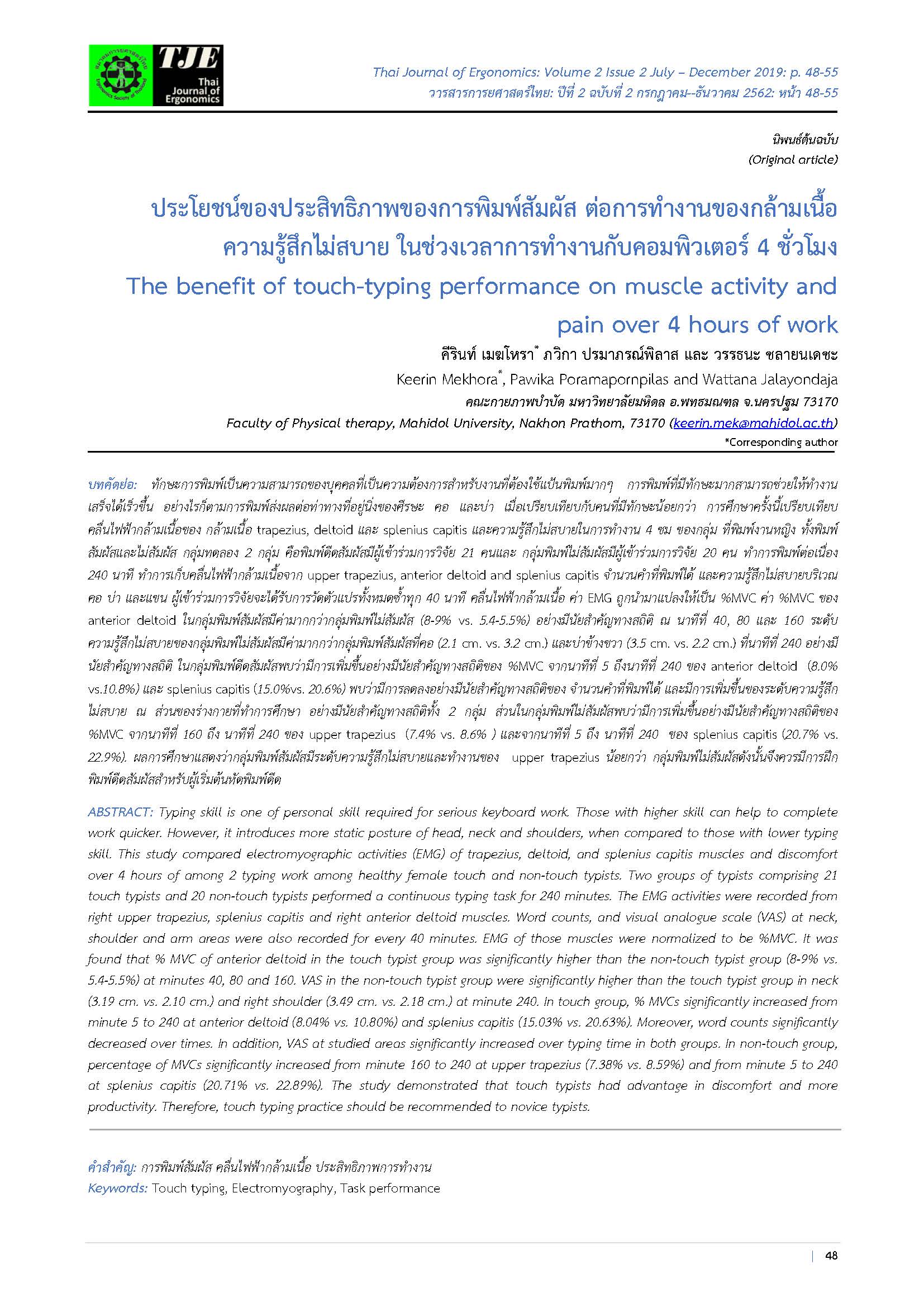The benefit of touch-typing performance on muscle activity and pain over 4 hours of work
Main Article Content
Abstract
Typing skill is one of personal skill required for serious keyboard work. Those with higher skill can help to complete work quicker. However, it introduces more static posture of head, neck and shoulders, when compared to those with lower typing skill. This study compared electromyographic activities (EMG) of trapezius, deltoid, and splenius capitis muscles and discomfort over 4 hours of among 2 typing work among healthy female touch and non-touch typists. Two groups of typists comprising 21 touch typists and 20 non-touch typists performed a continuous typing task for 240 minutes. The EMG activities were recorded from right upper trapezius, splenius capitis and right anterior deltoid muscles. Word counts, and visual analogue scale (VAS) at neck, shoulder and arm areas were also recorded for every 40 minutes. EMG of those muscles were normalized to be %MVC. It was found that % MVC of anterior deltoid in the touch typist group was significantly higher than the non-touch typist group (8-9% vs. 5.4-5.5%) at minutes 40, 80 and 160. VAS in the non-touch typist group were significantly higher than the touch typist group in neck (3.19 cm. vs. 2.10 cm.) and right shoulder (3.49 cm. vs. 2.18 cm.) at minute 240. In touch group, % MVCs significantly increased from minute 5 to 240 at anterior deltoid (8.04% vs. 10.80%) and splenius capitis (15.03% vs. 20.63%). Moreover, word counts significantly decreased over times. In addition, VAS at studied areas significantly increased over typing time in both groups. In non-touch group, percentage of MVCs significantly increased from minute 160 to 240 at upper trapezius (7.38% vs. 8.59%) and from minute 5 to 240 at splenius capitis (20.71% vs. 22.89%). The study demonstrated that touch typists had advantage in discomfort and more productivity. Therefore, touch typing practice should be recommended to novice typists.
Article Details

This work is licensed under a Creative Commons Attribution-NonCommercial-NoDerivatives 4.0 International License.
References
Punnett L, Wegman DH. Work-related musculoskeletal disorders: the epidemiologic evidence and the debate. J Electromyogr Kines 2004;14:13-23.
Ostrach TR. Typing Speed: How Fast is Average: 4,000 typing scores statistically analyzed and interpreted. Available from: https://cdn.shopify.com/s/files/1/0156/9110/files/Average-OrbiTouch-Typing-Speed.pdf
Fahrbach PA., Chapman LJ. VDT Work duration and musculoskeletal discomfort. AAOHN J 1990;38(1):32-6.
Brandis H, Straker L. The effect of touch typing skill on discomfort and performance in office workers. In: Thatcher, A. (Ed.), CybErg 2002. The Third International Cyberspace Conference on Ergonomics, World Wide Web, University of Witswaterand.


